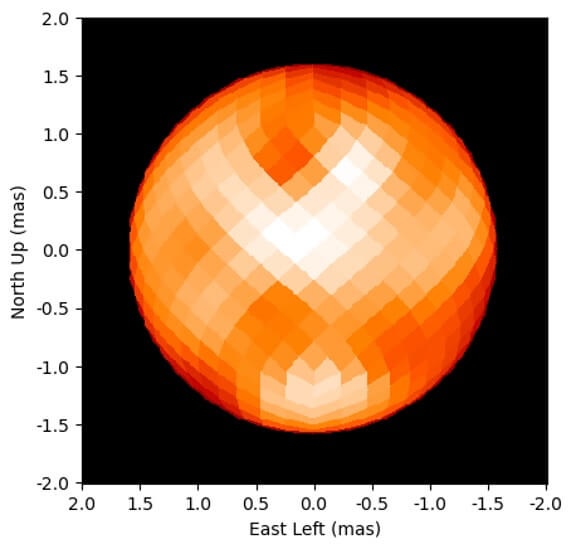Polaris, the North Star, has spots on it

- Polaris, the North Starwas the focus of the CHARA Array in California.
- Polaris is a variable starand these observations were the first glimpse of what the surface of a Cepheid variable star looks like.
- The most amazing thing was that Polaris has large bright and dark spots on it.
Georgia State University published this original story on August 20, 2024. Modified by EarthSky.
Polaris, the North Star, has spots on it
Researchers using Georgia State University’s Center for High Angular Resolution Astronomy (CHARA) Array have discovered new information about the size and appearance of the North Star, also known as Polaris. The most remarkable discovery was the large bright and dark spots on the star. The Astrophysical Journal published new peer-reviewed research on August 20, 2024.
The North Star is a variable star
The North Pole of the Earth points the way to the area marked by the North Star. Polaris is a navigation aid and a star in itself. It is the brightest member of the triple star system and is a variable star. Polaris brightens and dims periodically as the star’s diameter grows and shrinks over a four-day period.
Polaris is a type of star known as the Cepheid type. Astronomers use these stars as “common candles,” because their true brightness depends on the time of their explosion. Brighter stars fly more slowly than fainter stars. How bright a star is in the sky depends on the actual brightness of the star and its distance. Since we know the true brightness of a Cepheid based on the timing of its impact, astronomers can use it to measure the distances of host galaxies and measure the rate of expansion of the universe.
Learning Polaris
A team of astronomers led by Nancy Evans at the Center for Astrophysics | Harvard & Smithsonian observed Polaris using the CHARA optical interferometric array of six telescopes at Mount Wilson, California. The goal of the research was to map a close, faint companion that orbits Polaris every 30 years. Evans wrote:
The small separation and large brightness difference between the two stars makes it very difficult to resolve the binary system during their close approach.
The CHARA Array combines the light of six telescopes scattered over the mountain at the historic Mount Wilson Observatory. By combining the light, the CHARA Array acted as a 330-meter telescope to spot the faint companion as it passed near Polaris. Polaris observations were recorded using the MIRC-X camera, built by astronomers at the University of Michigan and the University of Exeter in the UK. .
The team successfully tracked the close companion’s orbit and measured the changes in Cepheid’s size as it rose. The orbital motion showed that Polaris has five times the mass of the sun. Images of Polaris have shown that its diameter is 46 times that of the sun.
An amazing view of its surface
The most surprising thing was the appearance of Polaris in the close-up pictures. CHARA’s observations provided the first glimpse of what the Cepheid-type surface looks like.
Gail Schaefer, director of the CHARA Array, said:
CHARA images revealed large bright and dark spots on Polaris that changed over time.
The presence of the spots and the rotation of the star can be related to the 120-day change in the measured speed. John Monnier, a professor of astronomy at the University of Michigan, said:
We plan to continue to consider Polaris in the future. We hope to better understand the mechanism that produces the spots on Polaris.
CHARA team
The new observations of Polaris were made and recorded as part of the open access program at the CHARA Array, where astronomers from around the world can request time through the National Optical-Infrared Astronomy Research Laboratory (NOIRLab). .

The CHARA Array open access program is supported by the National Science Foundation (grant AST-2034336). Institutional support for the CHARA Array is provided by Georgia State’s College of Arts & Sciences and the Office of the Vice Chancellor for Research and Economic Development.
Key point: Observations of Polaris, the North Star, show that it has large bright and dark spots on it. It’s the first glimpse of what a Cepheid-type surface looks like.
Source: The Orbit and Dynamical Mass of Polaris: Observations with the CHARA Array
Through Georgia State University
#Polaris #North #Star #spots
